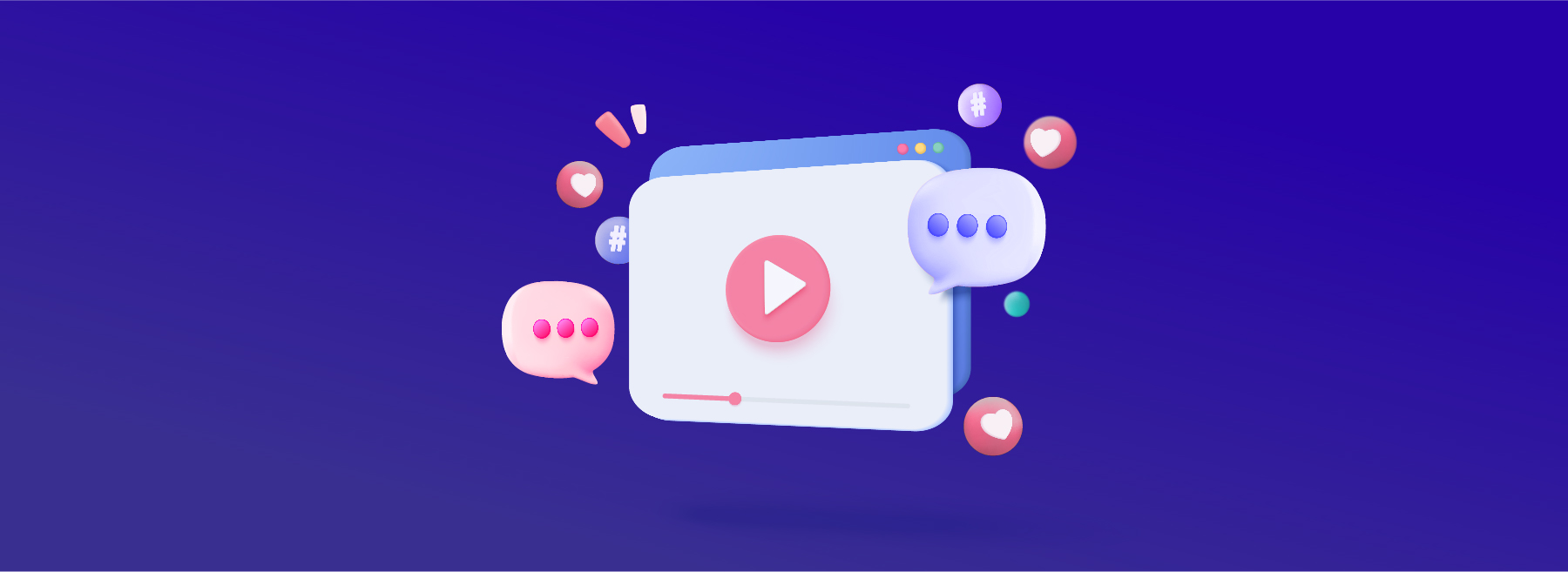
Social media is one of the most exciting marketing opportunities for healthcare brands today. Unfortunately, it’s often misunderstood. As audiences become increasingly fragmented across digital channels, healthcare social media marketing offers the perfect opportunity to form communities. It isn’t just for tech-savvy millennials anymore; middle-aged and elderly adults are some of social media’s fastest-growing demographics. People are engaging these platforms to talk about everything ranging from what they had for lunch to important topics like finances, relationships, and health. So how can you promote healthcare on social media?
Connecting with patients through social media means more than sharing information about your products or services; it’s about building connections and fostering a sense of community. By strategically using social media platforms, healthcare organizations and brands can keep patients and clients informed, motivated, and connected. Here are some strategies to help keep your audience stay engaged:
Social media accounts have the opportunity to inspire and uplift. Boost your healthcare social media marketing efforts by showcasing patient success stories, celebrating staff achievements, and highlighting moments that reflect the positive impact of your brand or organization’s work. These posts not only motivate your audience but also create a sense of unity and pride in being part of a community dedicated to making a difference.
Consider this example from March of Dimes:
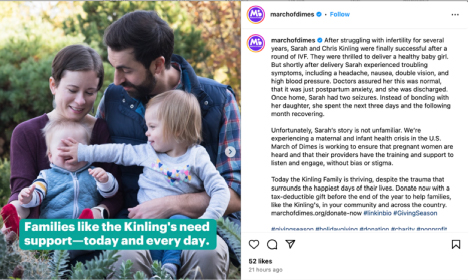
Craft healthcare social media campaigns that prioritize sharing user-generated content, such as testimonials and reviews, to highlight real experiences with your healthcare services. This not only serves as authentic social proof but also contributes to building a positive online reputation and bolstering your organization’s social media presence. Plus, acknowledging and appreciating your patients fosters a sense of community and gratitude.
Leverage the potential of hashtags to connect with a wider audience. Whether it’s creating your own organizational hashtags or tapping into healthcare-specific tags, hashtags can amplify your content’s reach and boost your healthcare social media marketing efforts. Capitalize on hashtag holidays related to health and wellness, aligning your campaigns with trending topics to maximize visibility and engagement. For example, Harvard Health Publishing, from Harvard’s Medical School, uses the hashtag #HarvardHealth on all their publications:
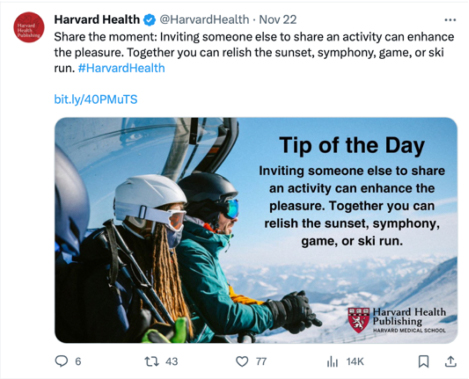
Whereas Mayo Clinic uses hashtags to raise awareness during specific holidays and events:
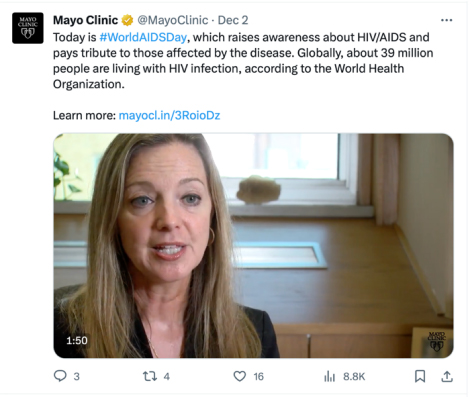
Harness the power of infographics to convey complex information in a visually appealing and digestible format. If you have relevant reports or studies that you’d like to share with your audience, consider transforming the data into engaging infographics. This not only enhances understanding but also encourages users to share your content, extending its reach and impact.
Providing valuable information is crucial in the healthcare industry. Regularly share educational content, such as blog posts, videos, and health tips, to keep your followers well-informed. Whether it’s general health advice or timely topics relevant to your organization, bite-sized information shared through social media can be a powerful tool. For instance, consider addressing trending health concerns or raising awareness about specific conditions, helping your audience stay updated and engaged. The Cleveland Clinic does an exceptional job posting educational content across their social media channels:
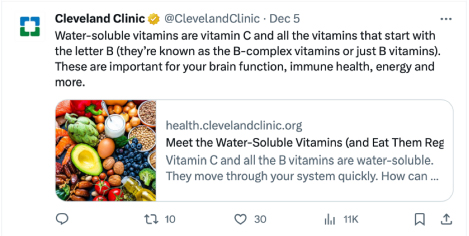
Healthcare social media marketing is not just about selling. Humanize your brand or healthcare organization by offering glimpses behind the scenes. Consider creating short videos or posts that provide a personal touch, showcasing the dedicated individuals who contribute to the organization. This approach helps build a connection between your audience and the human side of healthcare, fostering a deeper sense of community.
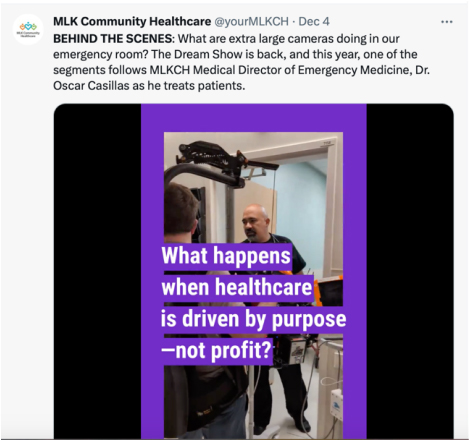
Consider integrating questions and polls into your healthcare social media marketing strategy. Social media platforms like X (formerly Twitter) offer a real-time opportunity to connect with patients by posing questions that elicit quick insights and opinions on health-related topics. Meanwhile, Instagram’s poll stickers can be used to craft visually appealing questions that resonate with your audience, inviting active participation and valuable feedback. By boosting engagement rates and aligning your content with the interests of your patient community, you can elevate the impact of your social media strategy.
Here’s an example from MedOptics:
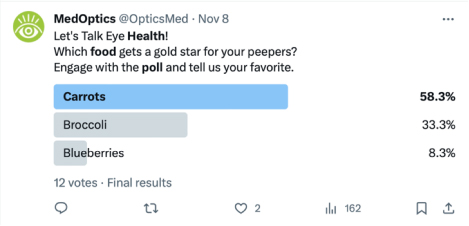
Every audience is unique and each one requires a slightly different social media strategy. With that said, there are some principles that apply regardless of which healthcare product or service you’re marketing. So, instead of trying to invent a social media strategy from scratch, you can follow the brands who are already doing it well and model their success.
1. Arkansas Children’s Hospital
As the only pediatric center in the state, Arkansas Children’s Hospital plays a key role in helping kids and young adults get the healthcare they need. They’re doing a lot more than just providing healthcare services. With social media’s help, they’re building vibrant communities where everyone involved–the children, their families, and hospital employees–feels welcome. The hospital is active on multiple social platforms, but one of the most interesting ones they’re using is Instagram. They aren’t posting boring stock photos with corporate speak. Instead, the photos are warm and inviting. Most importantly, they give us a glimpse of the people behind the organization. Here’s a photo of their heart and kidney transplant coordinators:
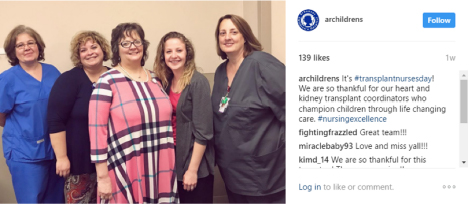
And here’s another one from their volunteer services celebrating the arrival of spring:
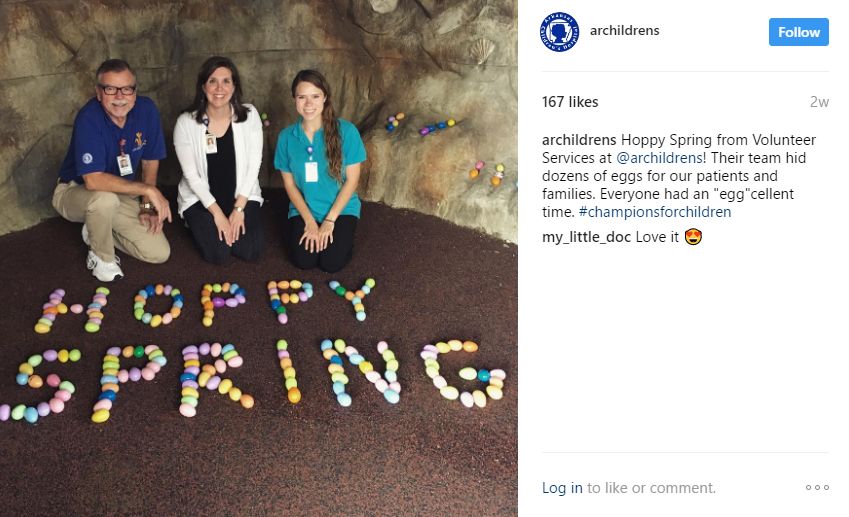
If you go through their Instagram posts, you’ll notice that the vast majority of the photos don’t seem “salesy” at all. They’re focused more on giving us a behind-the-scenes look at the people who make Arkansas Children’s Hospital special. Some posts are serious; others are silly. All of them come from the heart.
2. Zocdoc
Towards the end of 2016, Zocdoc, an online medical care scheduling service that helps people find the right healthcare providers, decided to launch an initiative called “Unsick day.” With the help of other corporate partners like Buffer and Foursquare, Zocdoc launched a social media campaign. The idea: encourage employees to take time off work while they were healthy to see providers and seek preventative care. The campaign was a big success, racking up over 70 million impressions in just two weeks. It even won a Shorty Award in the health and fitness category. The hashtag got people talking, as you can see from these Tweets below:
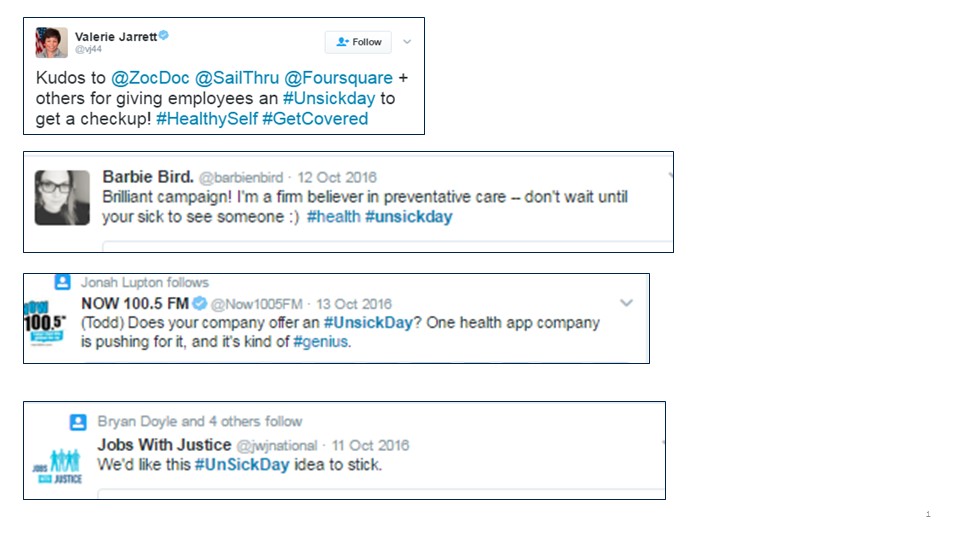
Where the campaign truly excelled was in video. The YouTube video below sums up the significance of both employers and employees putting more importance on preventive care.
While the Unsick day campaign is over now, its success shows the power of social media not just for sustained relationship-building, but for discrete marketing campaigns as well. If you’re trying to raise awareness for an overlooked health issue, a similar campaign (along with ongoing social media efforts) could help you cut through the noise and resonate with your audience.
3. ClearFlow
ClearFlow is a medical device manufacturer and one of our clients here at Bloom. You can check out how we designed their award-winning website here. ClearFlow’s primary mission is to keep patients’ chest tubes clear after operations, preventing the retention of blood and fluid in the chest cavity. Their device is incredibly innovative; the challenge lies in explaining the value of the technology in terms that both patients and providers can understand. One way ClearFlow does this is through social media. Their X account simplifies the technology visually, which makes the content easy to digest (and share).
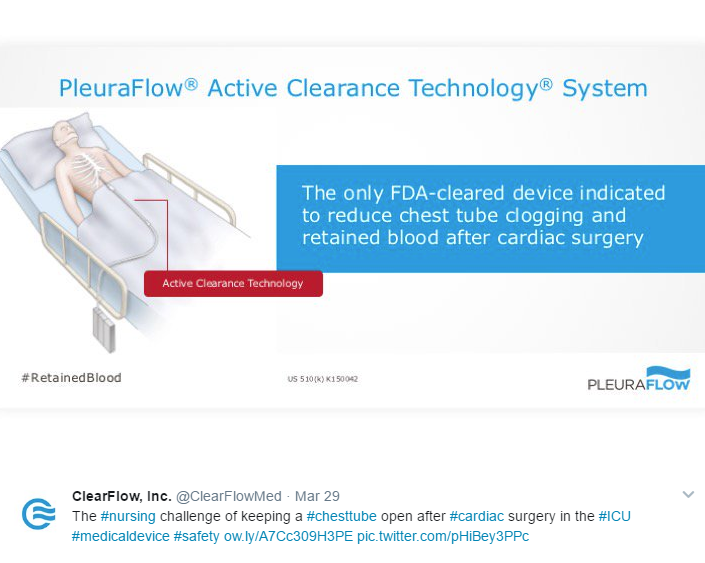
ClearFlow also uses X to highlight the severity of the Retained Blood Syndrome problem to help convince healthcare providers to investigate potential solutions.
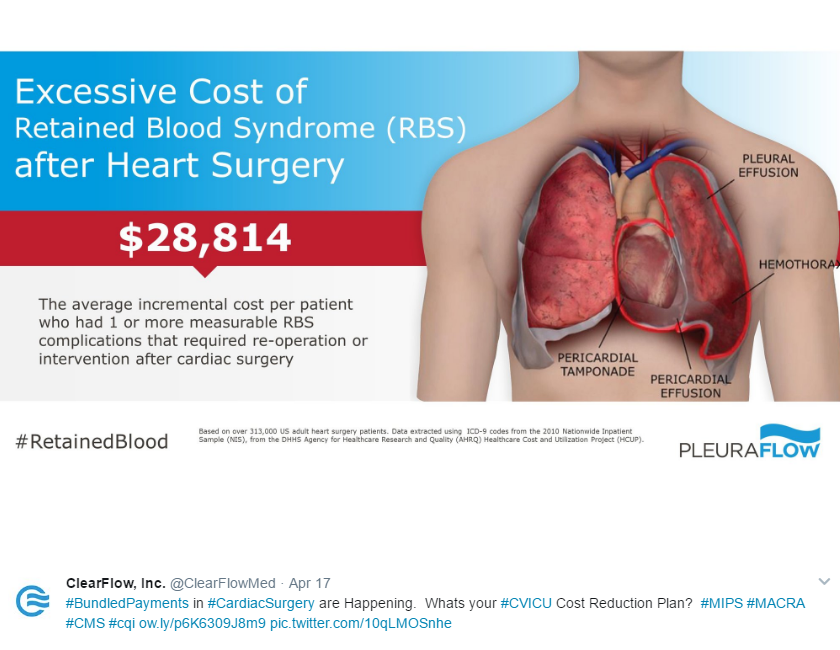
ClearFlow is active on other social media platforms too, including YouTube. Their short videos (most are under two minutes) are the perfect way for patients (and their providers) to see how the device works without slogging through complicated technical material.
4. Quest Diagnostics
Quest Diagnostics is a Fortune 500 company that provides clinical laboratory services. With the nature of their business and massive size, you can imagine it would be tough to build warm relationships with an audience. But Quest Diagnostics is using social media to do just that. One thing that stands out right away is their massive LinkedIn community. They curate a steady stream of content ranging from wellness tips and info about the latest scientific innovations to employee accolades. The common theme with their LinkedIn page is to contribute value relentlessly. Here’s a screenshot of their page so you get a better idea how they mix up the content.
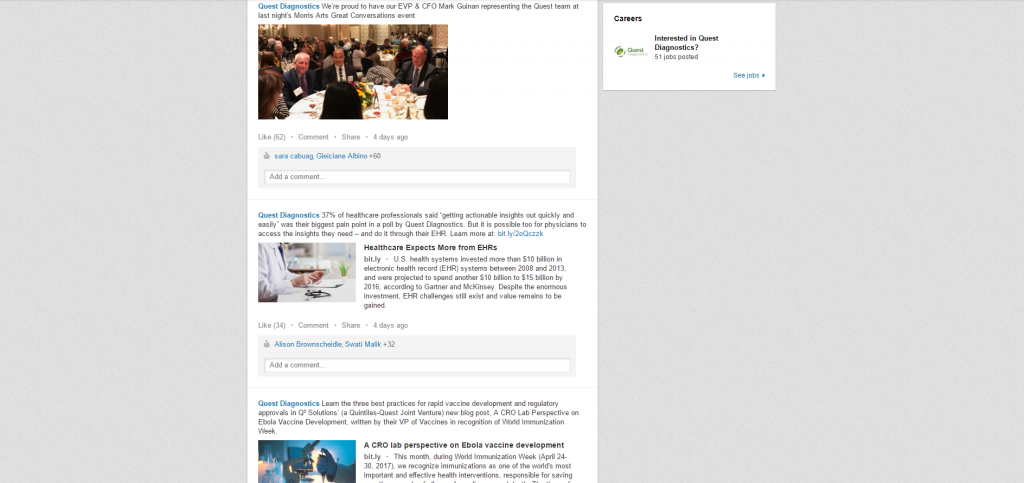
Their X (formerly Twitter) account is excellent because it addresses one of the major marketing challenges Quest faces: translating the quantitative value of their diagnostic equipment into tangible emotional benefits.
Without medical training, people might not appreciate all the benefits of testing blood glucose, heart rate, or something else. Quest uses X to convey them clearly.
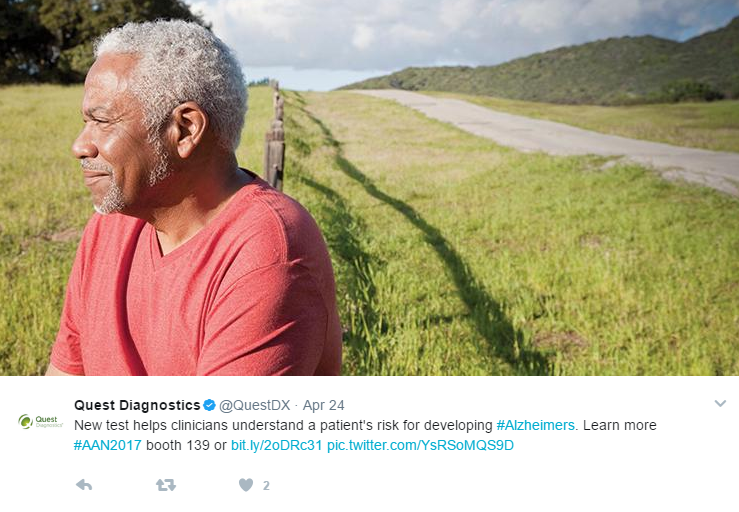
5. Doctors Without Borders
Doctors Without Borders shows that social media marketing can work for non-governmental organizations and nonprofits as well. This organization, which supplies crucial medical care to regions ravaged by war and disease, is active on multiple social media platforms. Its most remarkable is Instagram, which features over 2,000 posts of Doctor Without Borders staff, the patients they treat, and the health outcomes they achieve. Here’s a post about a measles vaccination campaign in Guinea:
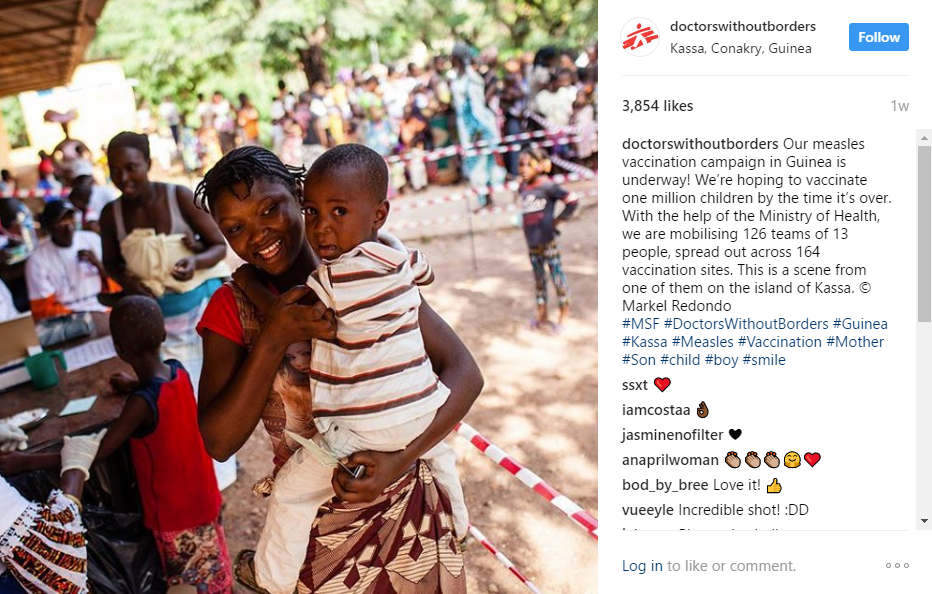
Doctors Without Borders also uses Instagram to highlight its employees’ experiences. Alongside their pictures, we can read about what drew them to the organization. These give us that cool behind-the-scenes look while encouraging other healthcare professionals to join.
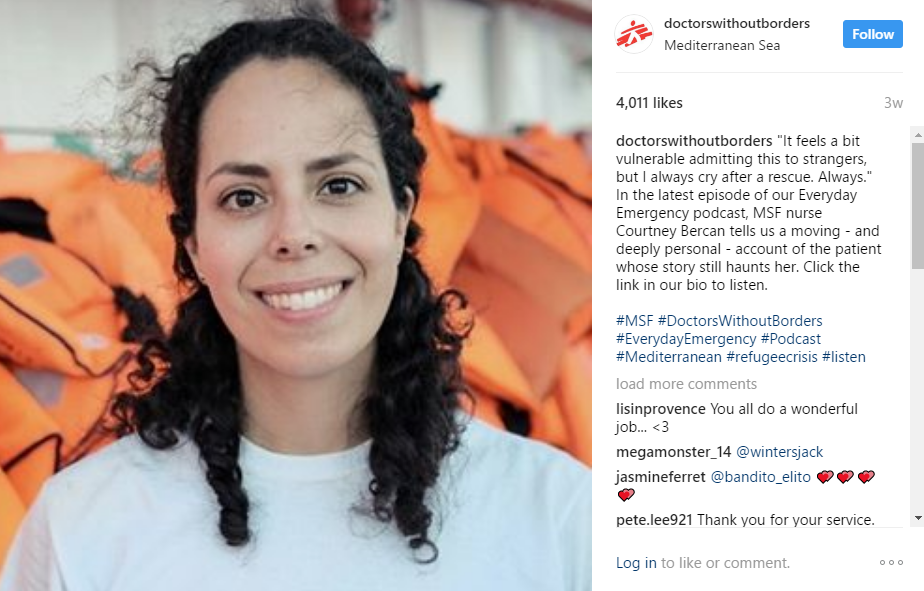
These photos are extremely high in quality, but they don’t look staged or overly produced. Because a part of us feels like we could have taken the photos ourselves, it’s easier to imagine being there and having a part in the community.
The short answer is all of them! The ideal social media platform for healthcare social media marketing depends on your content and strategic goals. For example, one platform might be great for quick insights and updates, whereas others work well for community engagement.
In general, different social media channels call for different approaches. Here’s a brief overview of each one:
X (Formerly Twitter) for Real-Time Updates: X’s fast-paced format is perfect for quick insights, brief conversations, and real-time updates. It’s ideal for healthcare organizations that want to engage with their audience promptly and communicate in a concise manner.
Facebook for Community Engagement: Facebook is excellent for fostering community engagement. With a range of features such as posts, comments, and live sessions, it offers plenty of opportunities for in-depth interactions.
Instagram for Visual Appeal: Instagram’s visual-centric approach is perfect for showcasing the human side of your healthcare brand or organization. You can use captivating images, reels, and short videos to show behind the scenes glimpses, celebrate achievements, and connect on a more personal level.
LinkedIn for Professional Networking: LinkedIn is great for professional networking within the healthcare industry. With a vast user base of professionals, it offers opportunities for physicians and healthcare organizations to connect, share insights, and stay up-to-date on industry trends.
TikTok for Creative Engagement: People tend to associate TikTok with off-beat lip-syncing and silly dancing videos –– and there are plenty. But with over 100 million active users in the US alone, TikTok offers a fantastic opportunity for brands to build an audience and boost their healthcare social media marketing efforts. Embracing the rising trend of short-form videos, TikTok offers a unique avenue for creative engagement. Healthcare brands can leverage this platform to share informative yet entertaining content, reaching a younger and broader population.
Build the Community Your Audience Craves
While your audience seeks connection online, you can use social media to create it at the perfect place and time. It takes time and commitment to pull this off. But if you incorporate the principles that healthcare brands are already using to build meaningful relationships, you’ll engage your audience with both head and heart.